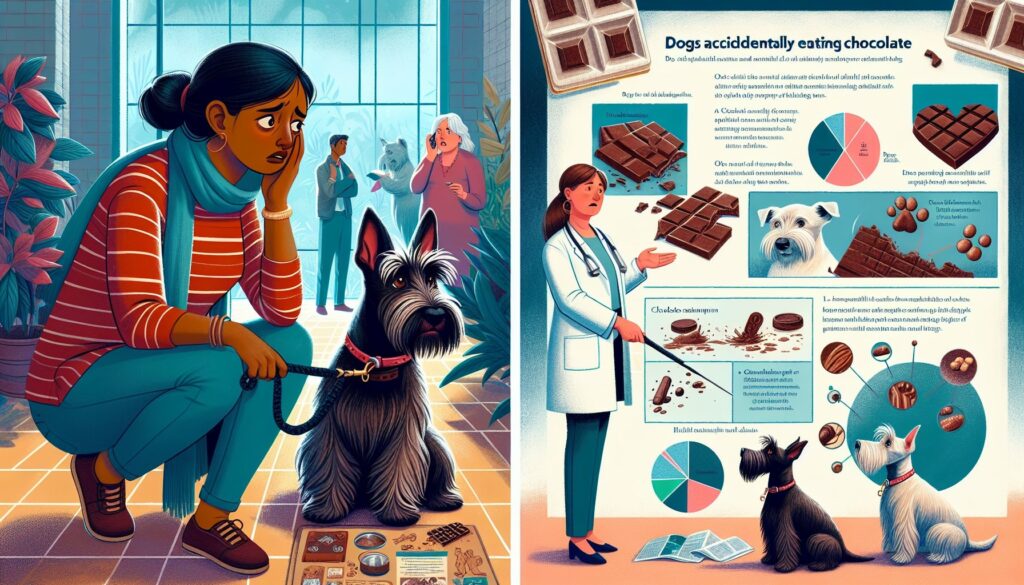Oh, how we fancy chocolate. That ancient civilization treat has a way of slipping its way into our hearts and while we cannot resist its appeal, dogs also find it irresistible. Yet, it’s a big no-no! So, what to do if your dog ate chocolate? Should you consult a vet ASAP or not? The answer is a big, fat YES. Chocolate contains theobromine, a substance doggoes cannot metabolize efficiently. The amount of chocolate and what kind of chocolate your dog consumed significantly impacts how toxic it might be for them.
Do you recall sneaking out milk chocolate bars from the top shelf, indulging in that sheer delight, only to find Rover, your beloved golden retriever, giving you that pleading look? Well, let me tell you – chocolate is not meant for the doggies as it stimulates their heart rate and could lead to a seizure.
Do you want to know more about what to do if your dog ate chocolate? Then use the table of contents below to jump to the most relevant section. And you can always go back by clicking on the black arrow in the right bottom corner of the page. Also, please note that some of the links in this article may be affiliate links. For more details, check the Disclosure section at the bottom of the page.
Here's what we'll cover:
- What are the Symptoms of Chocolate Poisoning in Dogs?
- How Much Chocolate is Toxic to Dogs and What Type of Chocolate is Most Dangerous?
- Immediate Steps to Take If Your Dog Ate Chocolate
- Calculating Toxic Dose Based on Dog’s Weight
- Preventive Measures and Tips to Keep Your Dog Safe from Chocolate Toxicity
What are the Symptoms of Chocolate Poisoning in Dogs?
Your hasty treat fest can quickly turn scary if your dog has eaten chocolate. You need to keep a keen eye on them for signs of chocolate poisoning which could range from mild symptoms to severe. Initially, you may observe restlessness, then they may have increased thirst, diarrhea, and even start vomiting. But that’s just the beginning. As the theobromine per ounce increases in their body weight, the mild symptoms may turn severe, including muscle tremors, seizures, and irregular heartbeats.
How Much Chocolate is Toxic to Dogs and What Type of Chocolate is Most Dangerous?
It’s not just the chocolate bar size that matters, the
Amount and Type of Chocolate Consumed
could spell disaster for Rover. Darker chocolate and baking chocolate have a higher theobromine concentration and therefore, are more dangerous than milk chocolate. It doesn’t matter if it’s a pretty little dog treat hiding the chocolate; chocolate toxicity can even result from just a small amount of baking chocolate. Consulting a chocolate toxicity calculator can immediately tell you how ominous that bar of chocolate your dog ate could be. Amount and Type of Chocolate Consumed Rover – a 60-pound, furry heap of love – will react differently to the same chocolate bar than a little fuzzball like a Pomeranian. The smaller the dog, the smaller the amount of chocolate needed to cause toxicity. Now imagine if the chocolate ingested were unsweetened baking chocolate, one of the most potent kinds. We’re free falling into disaster territory. So if you even see doggo licking a bar, it’s time to bring your dog to the vet. Remember, the sooner you can get the chocolate out of Rover’s system, the better!
Theobromine and Caffeine in Chocolate
Here’s something you may not know about those delicious chocolate bars we humans love to munch – they contain a chemical called theobromine. OK, I know what you’re thinking, that’s great, MomDog, but why does that matter? Well, sweeties, it turns out that our adorable 4-pawed friends can’t metabolize this theobromine as efficiently as we can. Our pup pals also struggle with the caffeine in the chocolate. And when we say struggle, we mean scary symptoms like vomiting, diarrhea, rapid breathing, seizures, and even cardiac arrest! The severity of the poisoning depends on the type and amount of theobromine your furry friend scarfed down.
Standard Milk Chocolate vs Dark Chocolate Toxicity
Now, listen up – not all chocolates are created equal, at least when it comes to our pooches. Different types of chocolate contain varying levels of theobromine and caffeine. For instance, a small dog who chows down on just 1.55 ounces of dark chocolate could already be displaying signs of toxicity. The same dose of chocolate in the milky kind results in substantially less drama. Dark chocolate is potentially more lethal to our pets, as it contains higher concentrations of theobromine compared to the milk version. So keep the dark, decadent treats stashed safely away from your playful pupper!

Immediate Steps to Take If Your Dog Ate Chocolate
Here we go, folks – the nitty gritty of what to do when your pup pulls a chocolate heist. First things first, don’t panic—it won’t help either you or your pooch. Make a quick guess of how much and what type of chocolate your dog gobbled. Time is important here, so don’t delay! Your next move should be a swift call to your veterinarian or the pet poison helpline.
Calling Your Veterinarian
After the initial shock settles in, it’s time to get proactive and call your vet. They are going to need some specifics – so get ready to pad out your pup’s biography. Expect to answer questions about the type and amount of chocolate consumed, your dog’s weight, and their general health. This will help your vet to gauge the level of emergency and guide your next steps. If your usual vet is closed, don’t hesitate to reach out to your nearest emergency vet.
Inducing Vomiting in Dogs
I know, I know. Vomit is gross. But sometimes, in pet emergencies, it’s necessary to move the toxins faster. If your vet gives the OK, you may be instructed to induce vomiting using hydrogen peroxide. Current guidelines recommend one teaspoon per pound of body weight. Why hydrogen peroxide? Well, it’s readily available and effective in dislodging that sneaky choco. Always remember though: the action you take should be guided by a professional. Your panic-stricken Googling is no match for a qualified veterinary opinion. So leave the treatment plan to them, and give your snacking scoundrel plenty of cuddles in the meantime. Remember, you know your dog best, so trust your instincts and seek help immediately if you notice any of the aforementioned symptoms.
Administering Activated Charcoal
It may sound a bit bizarre, but I did it myself, and it really comes in handy. Administering activated charcoal to your lovely pet can somewhat absorb the theobromine content from the ingested chocolate, impeding its absorption in your dog’s system. Not making it a habit, but consider it a remedy for severe cases. I mean, it’s not an anecdote, but worth trying in a pinch. Bear in mind that giving activated charcoal may best be done under the guidance of a vet or a pet poison helpline. If they say it’s necessary and you’ve got the go-ahead, go for it. But remember, your dog doesn’t need to suffer unnecessarily if chocolate ingestion was small and the dog’s size and overall health can metabolize theobromine effectively.
Keeping Your Dog Calm and Under Observation
After the first steps of addressing the chocolate scare, your dog’s mental state is of utmost importance. Keeping your dog calm is essential to prevent further damage to their cardiovascular system, which could be highly impacted due to the sudden increase in heart rate. Now, vigilance is key. Watch out for restlessness, frequent urination, tremors, or any sign of agitation. Any of these could imply the absorbed theobromine might be influencing your dog’s system negatively. In some severe cases, symptoms may last up to 72 hours. Document these too and report them accurately to your vet.
Calculating Toxic Dose Based on Dog’s Weight
As the good dog mom I am, I did my research. Your dog’s risk after eating chocolate significantly depends on the type of chocolate, the amount your pup consumed and your dog’s weight. Thankfully, there is an abundance of online calculators to estimate if your dog ate enough theobromine to cause a toxic reaction. However, these tools should never replace a call or visit to the vet. The precision of these calculators might not be 100%, and online resources can never replace targeted advice from a skilled veterinary professional.
Preventive Measures and Tips to Keep Your Dog Safe from Chocolate Toxicity
We all adore our dogs and would go extra miles to see them safe and sound. A key to avoiding the panic of chocolate ingestion? Prevention. Chocolate, in any form, is poisonous for dogs with possible effects ranging from diarrhea to seizures, and in severe cases, even sudden death can occur. Firstly, store chocolate out of your dog’s reach. Secondly, educate others that chocolate is toxic for dogs, including children. Lastly, get to know dog-friendly alternatives like carob, a close cousin of the cocoa plant but without harmful theobromine. Intravenous fluid treatment can be a lifesaver if your dog devours chocolate without you noticing within two hours of the act. Your vet will be the best person to refer to in such scenarios. Again, I can’t stress enough that contacting your vet ASAP is paramount to your dog’s health and survival.
Thanks for the blog graphics: Canva.com
Doghint.com is a participant of several affiliate programs. The list includes (but not limited to) the following: VigLink, Refersion, ShareASale, and Amazon Services LLC Associates Program, an affiliate advertising program designed to provide a mean for us to earn fees by linking to Amazon.com and affiliated sites. Doghint.com does not intend to provide veterinary advice. All published articles are meant for informational purposes only and not substitute the professional veterinary consultation.


